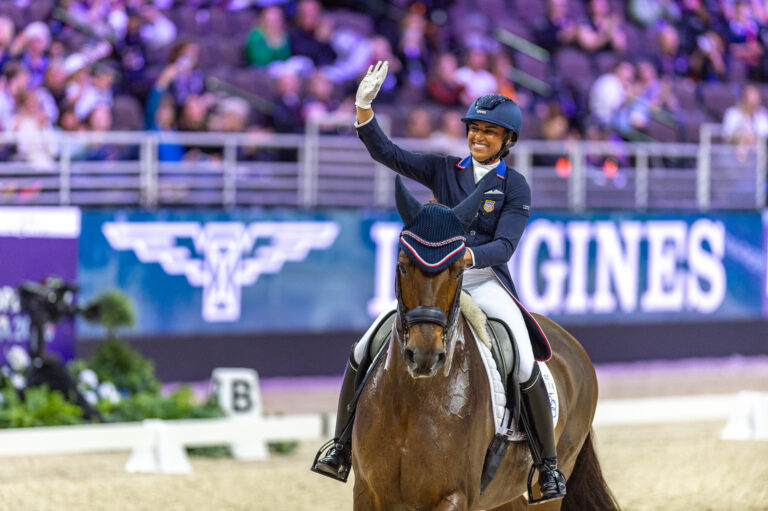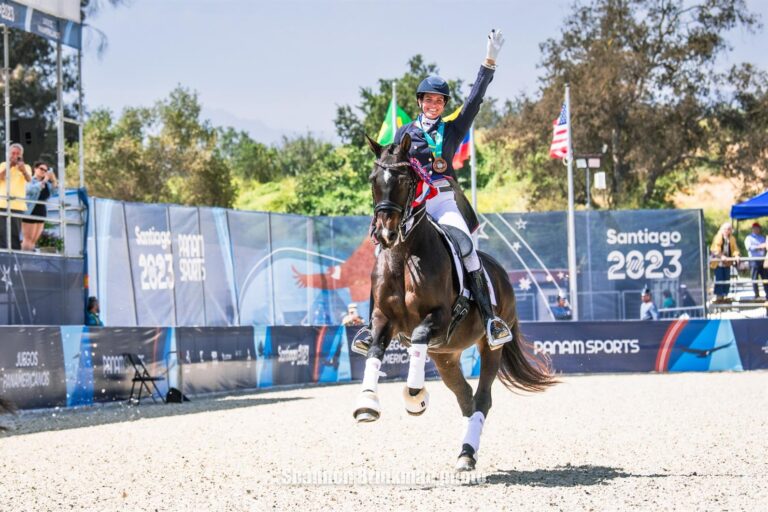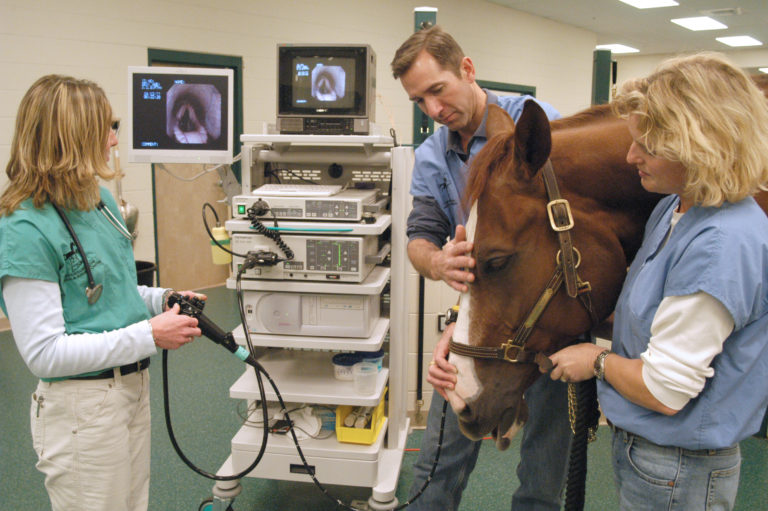The Ringling Bros. and Barnum & Baily Circus is scheduled to return this year without animals. There are only two greyhound racing tracks left in the United States. And SeaWorld ended its killer whale breeding program.

discussion about equestrian sport’s
“social-license to operate” at the
2023 U.S. Equestrian Annual
Meeting.
© Stephanie J. Ruff
As the general public has become increasingly concerned about animal welfare, the “social license to operate” has affected these industries and more. This social license is when an activity or industry has society’s approval or acceptance to continue.
And the competitive sporthorse world is not immune.
That was the message at the 2023 U.S. Equestrian Annual Meeting, in Lexington, Kentucky, April 12-14. “Are the practices in training and preparation able to stand the strongest scrutiny, not just from experts but to the public at large?” said U.S. Equestrian Chief of Sport David O’Connor on the first day of the meeting. “Can you train with current practices in the middle of Central Park NYC [in New York City] and defend your actions? If not, those practices cannot happen.”
The U.S. Equestrian Annual Meeting covered the topic of social license in a series of workshops titled, Working Together for Our Future. “I use this analogy quite a lot for big issues in equestrian sport in that there is a train on the tracks, and it is moving toward us,” O’Connor said. “First, we have to accept that there is a train and that we can stay out in front of it and not get run over because we refused to look down the tracks.”
After his initial comments, several experts described the breadth of the effect social license can have.
Equine Ethics and Wellbeing Commission
To address social license and equine welfare issues, the FEI formed a 10-member independent Equine Ethics and Wellbeing Commission in June 2022. “Our job is how can we do better for our horses and make this palatable for people who watch horse competition,” commission member Camie Heleski, PhD, said to U.S. Equestrian Annual Meeting attendees. She is a senior lecturer at the University of Kentucky’s College of Agriculture, Food and Environment.

Wellbeing Commission, spoke on the first day of the U.S.
Equestrian Annual Meeting.
© Sandra Oliynyk
Heleski presented the findings of two commission surveys. About 28,000 equestrians took one survey. And 14,000 members of the general public took another. The goal was to provide concrete data to help shape the commission’s proposals.
Among the surveys’ key findings were:
Clear evidence that both equestrians (75%) and the general public (65%) have concerns about the welfare of horses in sport78% within the equestrian community and 52% of the public believe horse welfare standards need to improve
2. 67% of the general public and 50% of surveyed equestrians believe horses sometimes or never enjoy being used in sport
Equestrians consider that to improve horses’ welfare:
current welfare rules must be better enforced
new welfare rules should be informed by science (i.e. when a noseband is super-tight, how many lesions are on the inside of a horse’s mouth)
those involved with horses should have a required level of equine welfare knowledge
In terms of how the public feels about the future of horse use in sport, Heleski said that roughly half say horse sport will continue, “but we have to be more proactive in improving the welfare and safety of horses.”
Overall, “we have to be really transparent and actively want to do the best thing for the horse,” Heleski said. “We want people like yourselves to be talking the talk, walking the walk.”
Learning from Other Industries
Roly Owers, chief executive of the World Horse Welfare organization, explained that social license is “an unwritten contract between the public sector allowing us to pursue our activities. … it will define [our] future. Can we continue to self-regulate or will we move to restrictions and in some parts, outright bans,” he said.

© Sandra Oliynyk
“Yes, social license is a challenge, but above all it’s an opportunity,” Owers told the audience at the U.S. Equestrian Annual Meeting.
Looking at other industries that started to lose social license can help. For example, Owers said the public criticized McDonald’s fast-food restaurant in the 1990s for it’s less-than ideal animal welfare practices. An assessment of the management of their cattle showed that less than 90 percent were correctly managed. Yet now it’s considered a leader in animal welfare and lauded for its progressive approach.
The turnaround happened after the restaurant chain brought in independent welfare scientists, including renowned animal behaviorist Temple Grandin, to evaluate their practices. They gave Grandin and other welfare organizations complete access to their facilities.
“They were transparent,” Owers said, which is fundamental to establishing the public’s trust. “The audience knows the difference between a group who says animal welfare important to those who show it.”
Another tip is making human-behavior change a central part of the strategy, Owers added. “People’s words and actions don’t always connect. Animal welfare will not improve without human-behavior change.”
Owers implored audience members to take the issue of animal welfare and social-license seriously. “The threat posed by changing attitudes to equestrianism is real and immediate. Prioritizing equine welfare is a major key to preserving equestrian sport.”
Don’t Be a ‘Horrible Warning’
Thoroughbred racing has had to work to ensure its social license, said the final speaker of the first day, Alex Waldrop, retired president and CEO of the National Thoroughbred Racing Association. “If you can’t be a good example, you’ll have to be a horrible warning,” he said.
Racing became a warning after 2006 Kentucky Derby winner Barbaro shattered his right hind leg during the Preakness Stakes. And in 2008, Eight Belles collapsed with two broken front ankles after she crossed the Derby finish line and veterinarians had to euthanize her on the track. At the time, the New York Times called horse racing a blood sport.
To help the horse and the sport, the racehorse industry banned the use of steroids in competition, Waldrop said. It also conducted a poll that revealed that the general public’s first priority in racing was the welfare of the horse.
The NTRA also created the Safety and Integrity Alliance that implemented significant safety regulations. Twenty-five racetracks committed to the reforms, but others didn’t.
Then Santa Anita Park came under fire after dozens of horse died on its racetrack. This was followed by a massive racehorse doping scandal in New York in 2020 in which 27 people were charged with giving horses performance-enhancing drugs.
After that, then-Senate Majority Leader Mitch McConnell pushed through the Horseracing Integrity and Safety Act in December 2020. HISA became an independent regulatory authority to enforce medication use and safety protocols. “Thoroughbred racing would be in jeopardy without it,” Waldrop said. “People want to know horses are safe, every horse, every day, every racetrack, from start to finish.
“I implore you to stay ahead of this. Do not become the horrible warning,” he concluded.
The Role of Social Media
The second day of workshops at the U.S. Equestrian Annual Meeting focused on the human side of social license and safety. Communications professional Sarah Hamiltondiscussed how social media affects social license. “If you take anything out of this meeting, think before you tweet, think before you post,” she said.

© Sandra Oliynyk
She shared some of the social coverage after NFL Buffalo Bills’ player Damar Hamlin collapsed on the field mid-game after suffering cardiac arrest. Fans and athletes reacted negatively to a tweet from Fox Sports’ Skip Bayless who questioned how the NFL could consider postponing such an important game.
Alternatively, ESPN “leaned into its humanity,” Hamilton said. The sports channel focused on Hamlin’s health and the emotional wellbeing of the two teams who were on the field when he went down. “Bad things happen to humans and to horses. Be human. Be empathetic,” Hamilton said.
A positive attribute of the horse industry is the great visuals of the horses, she explained. On social media, horse people can use photos and videos of their horses and include informational text to educate.
Hamilton covered social-media best practices, including:
Understand your goals
Have a good grasp of your tone-of-voice
Be authentic, relevant and consistent
Don’t overcommit by trying to be on all platforms, which can lead to burnout
Mix up your content with videos, images and graphics
Include a hook, call-to-action and link in your posts
Don’t overdo hashtags in social posts—”two is enough. If you use a ton, it just looks like you couldn’t decide.”
Create a sense of community if that aligns with your goals • Stress a sense of urgency or FOMO (fear of missing out) if necessary
Helmet and Body Protector Safety
Helmet and body protector/air-vest safety were the basis of Sydney Moriarty’s presentation. Moriarty participated in the Virginia Tech equestrian helmet ratings project. She also is a second-year medical student at the Edward Via College of Osteopathic Medicine in Blacksburg, Virginia.
As part of her presentation, Moriarty highlighted the timeline for safety-helmet use. It heated up after 1978 World Eventing Championships in Kentucky when a rider suffered a serious head injury. In 2021, the FEI required all equestrian athletes to wear fastened safety helmets.
These changes are important, Moriarty said, because out of the 30 million equestrian rides each year, 50,000 end up in emergency room visits for all types of injuries.
There are two testing standards for safety helmets, she added:
ASTM International/Safety Equipment Institute certification, which is based on a pass/fail system geared toward preventing skull fracture and catastrophic brain injury
Virginia Tech’s Helmet Lab’s recently released STAR protective headgear ratings system, which focuses on concussion risks
Moriarty also referenced four conflicting studies about the effectiveness of body protectors and air vests. This indicates a need for more research.
Her suggestions for making riders safer include increasing awareness for concussion recognition and using online concussion assessment tools. She also recommended updating post-concussion protocol developed to keep equestrians safer when returning to riding.
USEF Chief Marketing and Content Officer Vicki Lowell put a human face on the discussion, saying she was happy to be celebrating her birthday this month after a serious riding accident in 2022. “I encourage us as an industry to think of our friends and family. I would have died if I had not been wearing my air vest and safety helmet.”
SafeSport Update
The final workshop speaker at the U.S. Equestrian Annual Meeting was Ju’Riese Colón, chief executive officer of the U.S. Center for SafeSport. She shared the results of a survey on athlete climate and culture. About half of the survey’s 4,000 respondents were equestrians. The results include:
Nearly half of alleged survey respondents knew of coaches developing special relationship with students.
More than 90 percent of those who experienced unwanted sexual harassment or unwanted sexual contact did not submit a formal report.

Center for SafeSport, discusses progress the
center has made.
© Sandra Oliynyk
More than half of the athletes who ride and have had unwanted sexual experiences said that these experiences happened before they were 18.
18 percent of individuals having unwanted sexual experiences said they were retaliated against.
The center’s mission is to make athlete wellbeing the centerpiece of the nation’s sports culture through abuse prevention, education and accountability, Colón said. It is making sport safer by setting clear ground rules with the SafeSport Code of Conduct and the Minor Athlete Abuse Prevention Policy. It helps educate athletes and those around athletes about the warning signs of abuse and the power imbalances among athletes and trainers.
Colón said equestrian sport is challenging because there is more opportunity for trainers to be alone with kids, to groom them and to isolate them. “The one-to-one nature of the sport, compounded with travel, further compounds the problems we see,” she said. She also praised the equestrian community, saying the center has seen “dramatic changes over the years with how you operate. … If I had to rank sports in terms of culture change, I’d put equestrian pretty high on the list.”
Going Forward
U.S. Equestrian assigned each of the workshop attendees to specific tables. Each table had a mix of equestrians from different disciplines and breeds. For each of the two-day workshops, attendees at the table brainstormed questions and topics about social license.

© Sandra Oliynyk
Audience members liked the format. “It was a great departure kind of from the standard agenda because hearing from all of the breeds and disciplines in a big sort of think tank on this level is really important. To get everybody in one room and discuss issues that are really common to us all as horseman,” said eventer Carol Kozlowski, a member of the U.S. Equestrian board of directors, after the meeting. “This is really productive, and it actually makes us realize we have more similarities than we have differences.”
At the end of the two days of workshops, O’Connor said the USEF would collate and organize the ideas. It would then send them out to the members after the meeting.
“I’d like to keep going with this conversation,” he said, adding that he was encouraged by the members’ engagement and the “buzzing” he heard at the tables as people brainstormed. “That’s exciting because people think it’s an important issue going forward. It’s an important issue for the future of our sport.”











